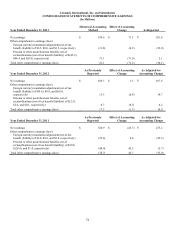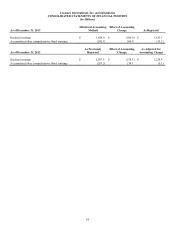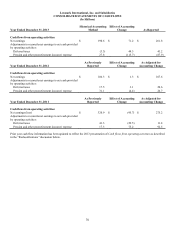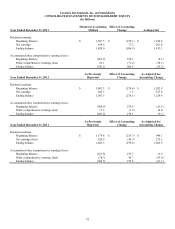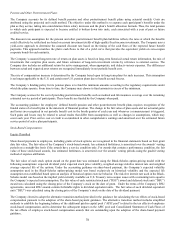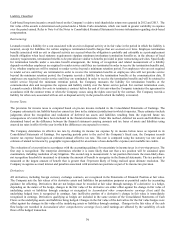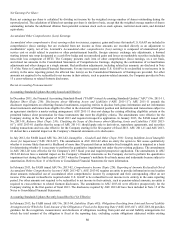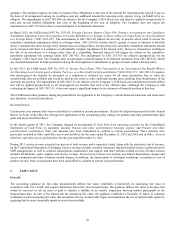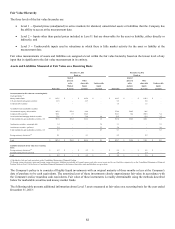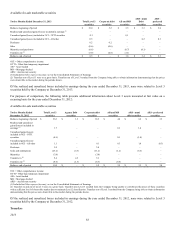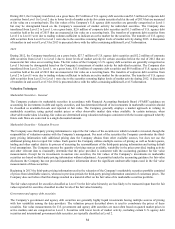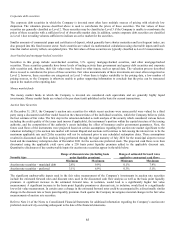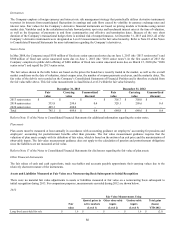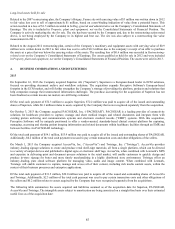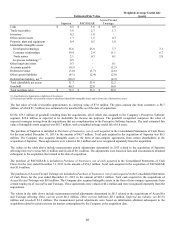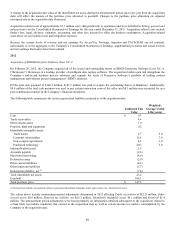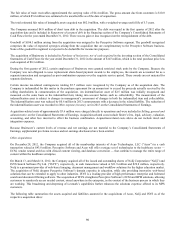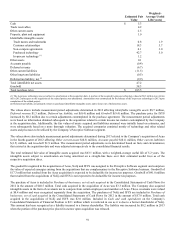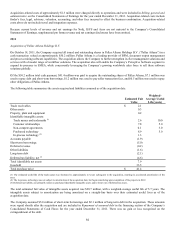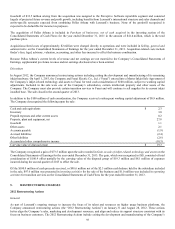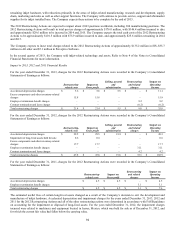Lexmark 2013 Annual Report Download - page 88
Download and view the complete annual report
Please find page 88 of the 2013 Lexmark annual report below. You can navigate through the pages in the report by either clicking on the pages listed below, or by using the keyword search tool below to find specific information within the annual report.
84
During 2013, the Company transferred, on a gross basis, $8.7 million of U.S. agency debt securities and $3.5 million of corporate debt
securities from Level 1 to Level 2 due to lower levels of market activity for certain securities held at the end of 2013 that are measured
at fair value on a recurring basis. The fair values of the Company’s U.S. agency debt securities are generally categorized as Level 1
but may be downgraded based on the Company’s assessment of market activity for individual securities. The Company also
transferred from Level 2 to Level 1, on a gross basis, $2.6 million of corporate debt securities and $1.5 million of U.S. agency debt
securities held at the end of 2013 that are measured at fair value on a recurring basis. The transfers of corporate debt securities from
Level 2 to Level 1 were due to trading volumes sufficient to indicate an active market for the securities. The transfers of U.S. agency
debt securities from Level 2 to Level 1 were due to the securities resuming higher levels of market activity during 2013. A discussion
of transfers in and out of Level 3 for 2013 is presented above with the tables containing additional Level 3 information.
2012
During 2012, the Company transferred, on a gross basis, $27.7 million of U.S. agency debt securities and $2.2 million of corporate
debt securities from Level 1 to Level 2 due to lower levels of market activity for certain securities held at the end of 2012 that are
measured at fair value on a recurring basis. The fair values of the Company’s U.S. agency debt securities are generally categorized as
Level 1 but may be downgraded based on the Company’s assessment of market activity for individual securities. The Company also
transferred from Level 2 to Level 1, on a gross basis, $11.8 million of corporate debt securities and $9.8 million of U.S. agency debt
securities held at the end of 2012 that are measured at fair value on a recurring basis. The transfers of corporate debt securities from
Level 2 to Level 1 were due to trading volumes sufficient to indicate an active market for the securities. The transfers of U.S. agency
debt securities from Level 2 to Level 1 were due to the securities resuming higher levels of market activity during 2012. A discussion
of transfers in and out of Level 3 for 2012 is presented above with the tables containing additional Level 3 information.
Valuation Techniques
Marketable Securities - General
The Company evaluates its marketable securities in accordance with Financial Accounting Standards Board (“FASB”) guidance on
accounting for investments in debt and equity securities, and has determined that all of its investments in marketable securities should
be classified as available-for-sale and reported at fair value. The Company generally employs a market approach in valuing its
marketable securities, using quoted market prices or other observable market data when available. In certain instances, when
observable market data is lacking, fair values are determined using valuation techniques consistent with the income approach whereby
future cash flows are converted to a single discounted amount.
Marketable Securities - Valuation Process
The Company uses third-party pricing information to report the fair values of the securities in which Lexmark is invested, though the
responsibility of valuation remains with the Company’s management. For most of the securities the Company corroborates the third-
party pricing information with additional pricing data the Company obtains from other available sources, but does not use the
additional pricing data to report fair values. Each quarter the Company utilizes multiple sources of pricing as well as broker quotes,
trading and other market data in its process of assessing the reasonableness of the third-party pricing information and testing default
level assumptions. The Company assesses the quantity of pricing sources available, variability in the prices provided, trading activity
and other relevant data to reasonably determine that the price provided is consistent with the accounting guidance for fair value
measurements. Except for its investments in auction rate securities, the fair values of the Company’s investments in marketable
securities are based on third-party pricing information without adjustment. As permitted under the accounting guidance for fair value
disclosures the Company has not provided quantitative information about the significant unobservable inputs used in the fair value
measurements of these securities.
Beginning in 2013 the third-party pricing information used in the valuation of the Company’s marketable securities portfolio consisted
of prices from identifiable sources, whereas in previous periods the third-party pricing information consisted of consensus prices. The
Company does not believe that this change resulted in a material effect on the fair value of its marketable securities portfolio.
The fair values reported for securities classified as Level 3 in the fair value hierarchy are less likely to be transacted upon than the fair
values reported for securities classified in other levels of the fair value hierarchy.
Government and agency debt securities
The Company’s government and agency debt securities are generally highly liquid investments having multiple sources of pricing
with low variability among the data providers. The valuation process described above is used to corroborate the prices of these
securities. Fair value measurements for U.S. government and agency debt securities are most often based on quoted market prices in
active markets and are categorized as Level 1. Securities with lower levels of market activity, including certain U.S. agency debt
securities and international government debt securities, are typically classified as Level 2.
84


